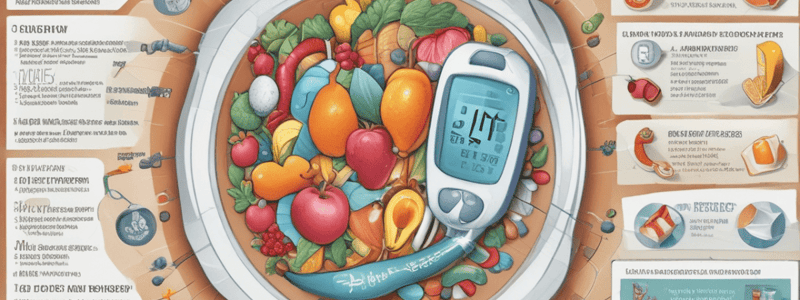Podcast
Questions and Answers
What is the primary difference between type Ⅱ DM and type Ⅰ DM?
What is the primary difference between type Ⅱ DM and type Ⅰ DM?
- Type Ⅱ DM is caused by a virus
- Type Ⅱ DM is characterized by insulin resistance (correct)
- Type Ⅱ DM is always asymptomatic
- Type Ⅱ DM is more prevalent in children
What is a key component of managing type Ⅱ DM?
What is a key component of managing type Ⅱ DM?
- Rest and relaxation
- Nutrition and exercise (correct)
- Surgery
- Medication only
Which of the following is a potential acute complication of type Ⅱ DM?
Which of the following is a potential acute complication of type Ⅱ DM?
- Nephropathy
- Hyperglycemia (correct)
- Retinopathy
- Hypoglycemia
What is the role of the nurse in managing type Ⅱ DM?
What is the role of the nurse in managing type Ⅱ DM?
What is a chronic complication of type Ⅱ DM?
What is a chronic complication of type Ⅱ DM?
Flashcards are hidden until you start studying
Study Notes
Type Ⅱ DM Pathophysiology and Clinical Manifestations
- Type Ⅱ DM is a metabolic disorder characterized by insulin resistance, impaired insulin secretion, and increased glucose production in the liver.
- Insulin resistance is the primary defect, leading to decreased glucose uptake in peripheral tissues, particularly in skeletal muscles.
- The body's inability to respond to insulin leads to hyperglycemia (high blood sugar levels).
- Clinical manifestations of type Ⅱ DM include:
- Polyuria (frequent urination)
- Polydipsia (increased thirst)
- Polyphagia (increased hunger)
- Fatigue
- Blurred vision
- Slow healing of cuts and wounds
- Recurring skin, gum, or bladder infections
Differentiation from Type Ⅰ DM
- Type Ⅱ DM is distinct from type Ⅰ DM, which is characterized by beta-cell destruction and absolute insulin deficiency.
- Type Ⅱ DM is often associated with insulin resistance, whereas type Ⅰ DM is associated with insulin deficiency.
- Type Ⅱ DM is more common than type Ⅰ DM, accounting for approximately 90% of all diabetes cases.
Nutrition and Exercise as Management Strategies
- Nutrition plays a crucial role in managing type Ⅱ DM, with a focus on:
- Reducing carbohydrate intake to regulate blood sugar levels
- Increasing fiber intake to improve insulin sensitivity
- Incorporating healthy fats, such as omega-3 fatty acids, to reduce inflammation
- Exercise is essential for improving insulin sensitivity, reducing cardiovascular risk, and enhancing overall health.
- Regular physical activity, such as aerobic exercise and strength training, can help improve glucose uptake in peripheral tissues.
Nursing and Interdisciplinary Management
- Nursing management involves:
- Educating patients on self-care practices, including glucose monitoring, insulin administration, and foot care
- Providing emotional support and promoting healthy lifestyle habits
- Collaborating with healthcare professionals to develop individualized care plans
- Interdisciplinary management involves:
- Coordinating with healthcare providers, including primary care physicians, endocrinologists, and registered dietitians
- Encouraging patient participation in care planning and decision-making
- Fostering effective communication among healthcare team members
Pathophysiology and Complications
- The pathophysiology of type Ⅱ DM can lead to acute complications, such as:
- Hypoglycemia (low blood sugar levels)
- Hyperglycemic hyperosmolar nonketotic syndrome (HHNS)
- Diabetic ketoacidosis (DKA)
- Chronic complications of type Ⅱ DM can include:
- Microvascular complications, such as nephropathy, neuropathy, and retinopathy
- Macrovascular complications, such as cardiovascular disease, peripheral artery disease, and stroke.
Studying That Suits You
Use AI to generate personalized quizzes and flashcards to suit your learning preferences.



